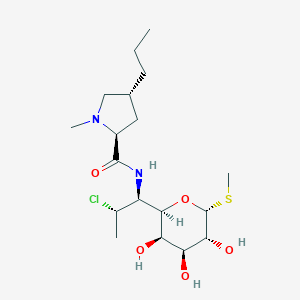| 1 |
ClinicalTrials.gov (NCT03261830) Antibiotics Usage in Pediatric Orthopaedic Percutaneous Surgery (APOPS)
|
| 2 |
Drugs@FDA. U.S. Food and Drug Administration. U.S. Department of Health & Human Services. 2015
|
| 3 |
Clindamycin FDA Label
|
| 4 |
Cefazolin FDA Label
|
| 5 |
FDA Approved Drug Products from FDA Official Website. 2009. Application Number: (ANDA) 065244.
|
| 6 |
Structural basis for the interaction of antibiotics with the peptidyl transferase centre in eubacteria. Nature. 2001 Oct 25;413(6858):814-21.
|
| 7 |
In vitro metabolism of clindamycin in human liver and intestinal microsomes. Drug Metab Dispos. 2003 Jul;31(7):878-87.
|
| 8 |
Comparison of antimicrobial susceptibility, beta-lactamase production, plasmid analysis and serum bactericidal activity in Edwardsiella tarda, E. ictaluri and E. hoshinae. J Med Microbiol. 1993 Oct;39(4):273-81.
|
| 9 |
A comprehensive in vitro and in silico analysis of antibiotics that activate pregnane X receptor and induce CYP3A4 in liver and intestine. Drug Metab Dispos. 2008 Aug;36(8):1689-97.
|
| 10 |
Systems pharmacological analysis of drugs inducing stevens-johnson syndrome and toxic epidermal necrolysis. Chem Res Toxicol. 2015 May 18;28(5):927-34. doi: 10.1021/tx5005248. Epub 2015 Apr 3.
|
| 11 |
Chloramphenicol causes mitochondrial stress, decreases ATP biosynthesis, induces matrix metalloproteinase-13 expression, and solid-tumor cell invasion. Toxicol Sci. 2010 Jul;116(1):140-50. doi: 10.1093/toxsci/kfq085. Epub 2010 Mar 25.
|
| 12 |
Bacteriological characteristics of Staphylococcus aureus isolates from humans and bulk milk. J Dairy Sci. 2008 Feb;91(2):564-9.
|
| 13 |
Organic anion transporting polypeptide 1B1: a genetically polymorphic transporter of major importance for hepatic drug uptake. Pharmacol Rev. 2011 Mar;63(1):157-81.
|
| 14 |
Oral availability of cefadroxil depends on ABCC3 and ABCC4. Drug Metab Dispos. 2012 Mar;40(3):515-21.
|
| 15 |
Three-dimensional quantitative structure-activity relationship analyses of beta-lactam antibiotics and tripeptides as substrates of the mammalian H+/peptide cotransporter PEPT1. J Med Chem. 2005 Jun 30;48(13):4410-9.
|
| 16 |
Expression levels of renal organic anion transporters (OATs) and their correlation with anionic drug excretion in patients with renal diseases. Pharm Res. 2004 Jan;21(1):61-7.
|
| 17 |
Cefazolin administration and 2-methyl-1,3,4-thiadiazole-5-thiol in human tissue: possible relationship to hypoprothrombinemia. Drug Metab Dispos. 2002 Oct;30(10):1123-8.
|
| 18 |
Analysis of the drug-resistant characteristics of Klebsiella pneumoniae isolated from the respiratory tract and CTX-M ESBL genes. Genet Mol Res. 2015 Oct 5;14(4):12043-8.
|
| 19 |
Citrobacter freundii bacteremia: Risk factors of mortality and prevalence of resistance genes. J Microbiol Immunol Infect. 2018 Aug;51(4):565-572.
|
| 20 |
Prevalence of antimicrobial resistance genes in Bacteroides spp. and Prevotella spp. Dutch clinical isolates. Clin Microbiol Infect. 2019 Sep;25(9):1156.e9-1156.e13.
|
| 21 |
ClinicalTrials.gov (NCT04516148) A Randomized, Controlled Trial of the Effectiveness of Perioperative Antibiotics for Reduction of Burn Wound Bacterial Concentration Following Grafting
|
|
|
|
|
|
|


